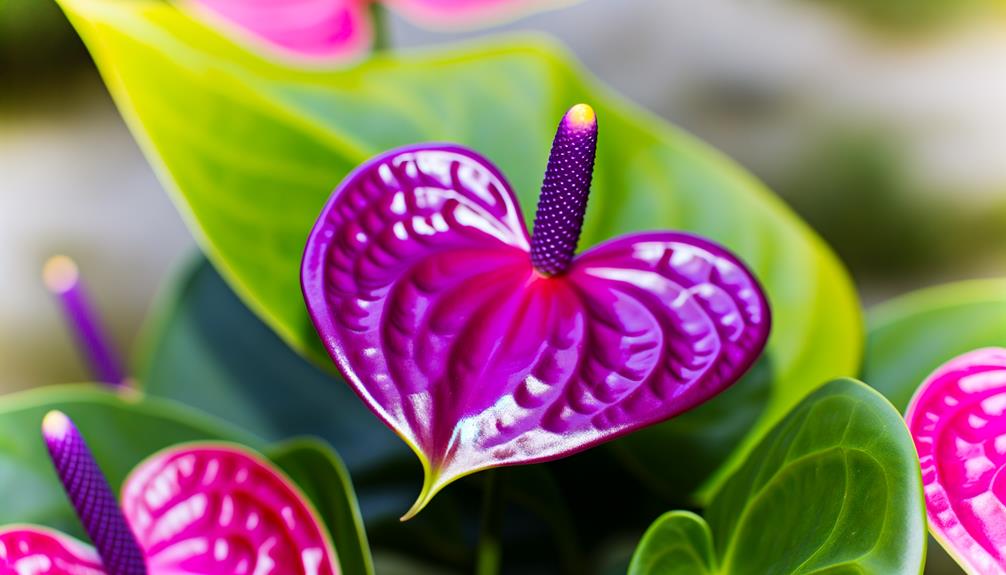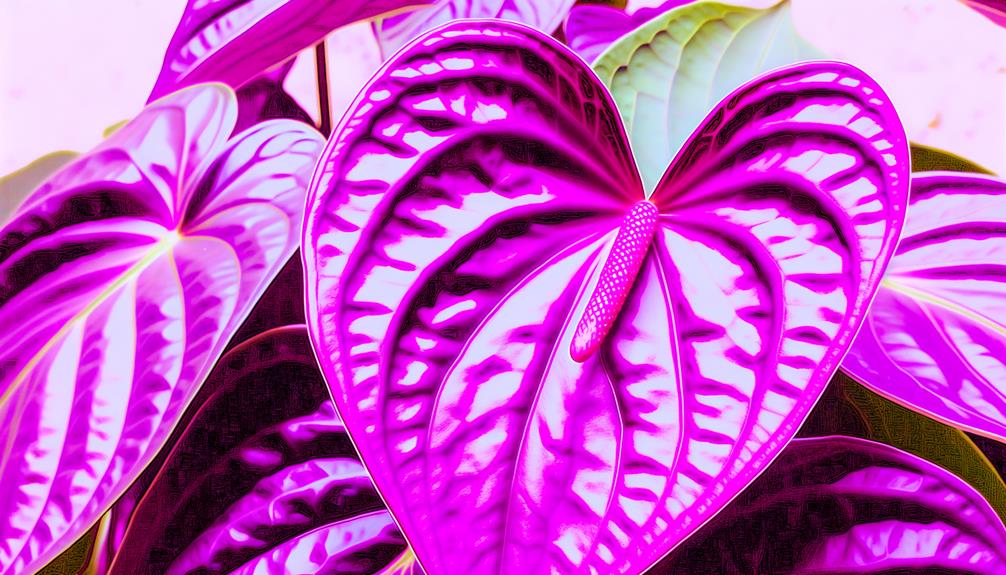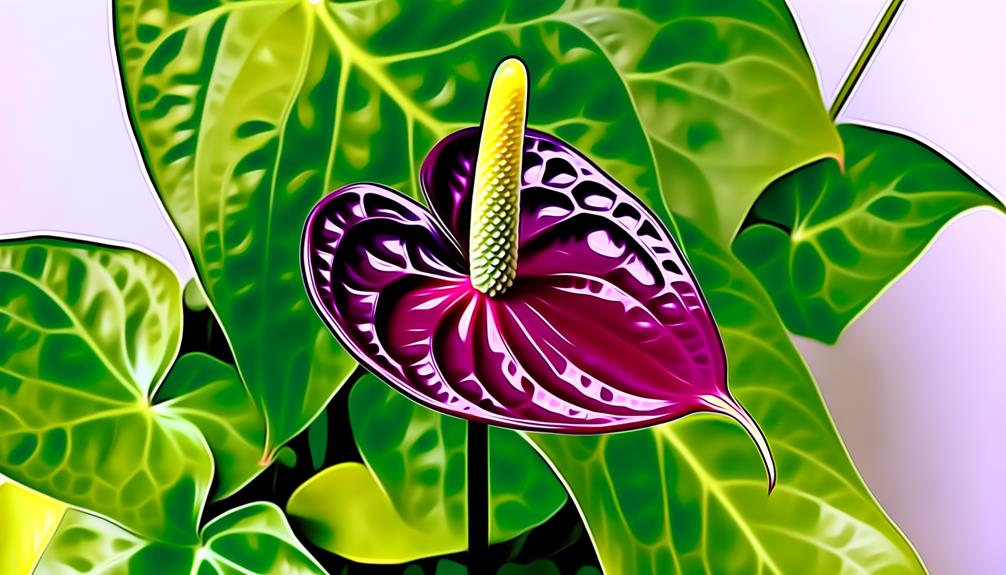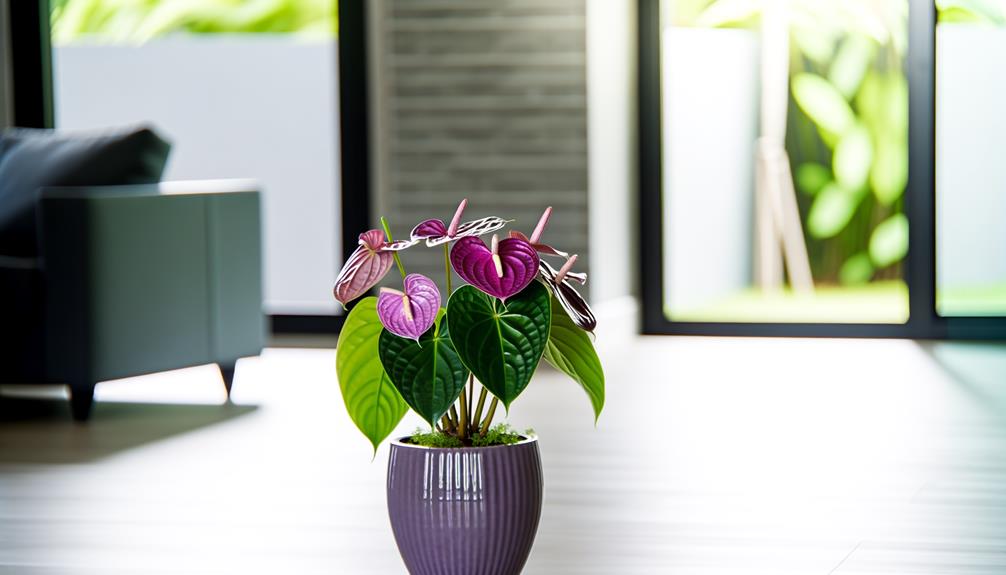Why Is Anthurium Ace of Purple Unique? Discover!
Anthurium Ace of Purple is unique for its stable, vibrant purple hue, thanks to high anthocyanin concentrations. This tropical plant thrives in bright, indirect light and demands consistent temperatures (65-80°F) and high humidity (60-80%).
Its thick, glossy leaves and robust, upright growth make it a striking addition to any space. Ensure well-draining soil, regular misting, and monthly balanced fertilizer for best health.
Individual blooms can last weeks if humidity and temperature are maintained. Interested in achieving peak bloom longevity and overcoming common cultivation challenges? Continue to expand your understanding of this remarkable plant’s needs!

Key Takeaways
- Anthurium Ace of Purple’s rich purple hue remains stable under various lighting conditions due to high anthocyanin concentration.
- Originating from tropical rainforests, it thrives in low light and high humidity, making it ideal for indoor environments.
- The plant features robust, upright growth with thick, glossy leaves arranged in a rosette pattern.
- It enhances indoor aesthetics with striking purple blooms that last several weeks.
- Anthurium Ace of Purple improves air quality by filtering toxins like formaldehyde, ammonia, and xylene.
Origins and History

The Anthurium Ace of Purple, a remarkably distinct variety, traces its roots back to the tropical rainforests of Central and South America where it evolved to flourish in the damp, shaded undergrowth.
You’ll find its roots tangled with the forest floor’s abundant, natural material, providing necessary nutrients.
This plant adapted to low light and high humidity, making it perfect for indoor cultivation. When you replicate these conditions—consistent moisture, indirect sunlight, and well-draining soil rich in natural material—you’ll see peak growth. Maintain temperatures between 65-80°F, and mist regularly to imitate its natural environment.
Monitoring for pests like spider mites will guarantee your Anthurium remains healthy. Understanding its origins helps you cater to its specific needs, nurturing a lush, vibrant plant.
Distinctive Coloration
You’ll notice that the Anthurium Ace of Purple exhibits a rich purple hue that remains stable under various lighting conditions.
To maintain its vivid coloration, make sure it receives indirect sunlight and consistent watering. This plant’s striking visual appeal makes it a standout addition to any botanical collection.
Rich Purple Hue
Characterized by a rich purple shade, Anthurium Ace of Purple stands out with its vibrant, deep coloring that adds a striking visual element to any botanical collection.
You’ll notice the purple pigment is due to high anthocyanin concentration, which provides both aesthetic appeal and protection against UV radiation.
To maintain this stunning shade, make sure your Anthurium receives indirect, bright light; direct sunlight can cause color fading.
Keep the soil consistently moist but not waterlogged, as proper hydration is essential for pigment maintenance.
Additionally, a well-draining potting mix with organic matter supports nutrient uptake, enhancing coloring.
Regularly misting the leaves can also help maintain humidity levels, promoting overall health and vibrancy. Cultivating this plant with care ensures its unique shade remains vivid and enthralling.
Color Stability
Maintaining the rich purple shade of Anthurium Ace of Purple hinges not only on proper lighting and hydration but also on understanding the stability of its distinctive coloring.
You’ll need to provide bright, indirect light; direct sunlight can cause fading. Consistent moisture is essential, but avoid waterlogging the roots. Balance is key—overwatering can lead to root rot, which compromises color stability.
Ensure humidity levels remain high, ideally above 60%. Supplement with a balanced, slow-release fertilizer to support vibrant pigmentation. Keep an eye on temperature; fluctuations can stress the plant, leading to color instability.
Visual Appeal
The distinct coloring of Anthurium Ace of Purple, often admired for its deep, vibrant tint, is a result of careful cultivation practices that guarantee the plant’s visual appeal remains unmatched.
You’ll notice the intensity of its purple spathes, which are achieved through controlled light exposure and precise nutrient management.
This anthurium thrives in indirect sunlight, making sure the pigments develop fully without fading. Regular feeding with a balanced, high-phosphorus fertilizer will enhance the coloring, promoting vivid blooms.
Additionally, maintaining humidity levels between 70-80% is essential for preserving the plant’s luster.
Growth Habits

Anthurium Ace of Purple Unique exhibits a robust and upright growth habit, making it a striking addition to any indoor garden.
You’ll notice its thick, glossy leaves emerge in a rosette pattern, providing a lush and compact structure. The stems are sturdy, supporting the plant’s striking spathes and inflorescences.
- Leaf formation: New leaves unfurl in a pleasing spiral, each one more vibrant.
- Root system: Its roots are well-developed, ensuring stability and efficient nutrient uptake.
- Growth rate: You’ll see steady growth throughout the year, with a peak during warmer months.
- Height and spread: It typically reaches a mature height of 18-24 inches, with a similar spread.
This unique habit makes the Anthurium Ace of Purple an eye-catching focal point.
Care Requirements
To keep the Anthurium Ace of Purple Unique thriving, you’ll need to consider its specific care requirements, including ideal light, water, and soil conditions.
This plant thrives in bright, indirect sunlight; excessive direct light can scorch its leaves, while inadequate light diminishes its vibrant coloration.
Water it when the top inch of soil feels dry, maintaining a balance to avoid root rot. Opt for well-draining soil rich in organic matter to support its root structure.
Humidity is essential, so mist the leaves regularly or use a humidifier to keep the air moisture high.
Fertilize monthly with a balanced, water-soluble fertilizer during the growing season to promote robust growth.
Attentive care guarantees your Anthurium Ace of Purple remains a stunning focal point.
Bloom Longevity

Understanding bloom longevity for your Anthurium Ace of Purple Unique involves recognizing that individual flowers can last several weeks under ideal conditions.
To maximize this duration, focus on creating an ideal environment:
- Humidity: Maintain humidity levels between 60-80% to prevent desiccation.
- Temperature: Keep temperatures between 65-80°F, avoiding sudden fluctuations.
- Light: Provide bright, indirect light to sustain photosynthesis without scorching the delicate petals.
- Watering: Ensure consistent moisture by watering when the top inch of soil feels dry, avoiding waterlogging.
These conditions help the Anthurium Ace of Purple Unique maintain its vibrant purple blooms, enhancing both aesthetic appeal and the plant’s overall health.
By carefully managing these factors, you’ll enjoy extended bloom periods, deepening your connection to this extraordinary plant.
Popularity Among Collectors
You’ll find that Anthurium Ace of Purple Unique is highly coveted among collectors due to its rare availability and vibrant aesthetic appeal.
This species exhibits striking purple spathes and lush foliage, making it a standout addition to any collection.
However, its popularity is also driven by the cultivation challenges it presents, requiring precise humidity and light conditions for best growth.
Rare Availability
Highly sought after by plant enthusiasts, the Anthurium Ace of Purple stands out for its striking foliage and limited availability, making it a prized addition to any serious collection.
Its rarity stems from:
- Limited propagation: This species doesn’t multiply easily, requiring skilled horticulturists for successful growth.
- Specialized care needs: It thrives in high humidity and indirect light, conditions not easily replicated.
- Slow growth rate: Patience is essential as new leaves take time to develop.
- Niche market: Collectors often have to wait for specific seasons or rare sales.
To nurture your Anthurium Ace of Purple, make sure it’s placed in a well-draining substrate, maintain a consistent watering schedule, and provide adequate airflow. This meticulous care elevates its status among collectors and enhances its intrinsic value.
Vibrant Aesthetic Appeal
The lively visual charm of the Anthurium Ace of Purple, characterized by its deep purple, heart-shaped leaves and glossy finish, captivates collectors and elevates its popularity within the horticultural community.
You’ll find that this plant’s unique pigmentation results from high anthocyanin levels, giving it a striking, almost regal appearance. Its foliage not only adds a touch of elegance to any collection but also thrives under indirect light, which helps maintain its vivid coloration.
When watering, make sure the soil remains moist but not waterlogged to prevent root rot. Employ a well-draining, organic-rich substrate to support its growth.
Cultivation Challenges
Cultivating the Anthurium Ace of Purple often presents challenges due to its specific environmental needs and susceptibility to pests and diseases.
You’ll need to mimic its native tropical habitat, maintaining high humidity and consistent temperatures. This plant doesn’t thrive if these conditions aren’t met, making it a bit finicky.
Humidity: Maintain levels between 70-80%. Use a humidifier if needed.
Temperature: Keep the range between 65-75°F. Avoid cold drafts.
Watering: Ensure the soil stays moist but not waterlogged. Overwatering can lead to root rot.
Pests: Watch for common pests like aphids and spider mites. Regularly inspect leaves and use insecticidal soap.
These intricacies make the Anthurium Ace of Purple a treasured possession among devoted collectors.
Benefits as a Houseplant

Boasting strikingly vibrant purple blooms, Anthurium Ace of Purple offers numerous benefits as a houseplant, including improved air quality and a touch of tropical elegance to your indoor space.
Its large, glossy leaves are efficient at filtering airborne toxins like formaldehyde, ammonia, and xylene, creating a healthier environment.
The plant thrives in indirect light and prefers high humidity, mimicking its native tropical habitat. Water it consistently, ensuring the soil remains moist but not waterlogged. Fertilize monthly with a balanced, water-soluble fertilizer to promote vibrant growth.
With its unique coloration and air-purifying properties, Anthurium Ace of Purple not only enhances your home’s aesthetics but also supports your well-being, making it an ideal companion for any indoor gardener.
Common Challenges
Despite its many benefits, you might encounter some common challenges when caring for Anthurium Ace of Purple, such as managing pests like aphids and spider mites, preventing root rot, and maintaining ideal humidity levels. Vigilance and prompt action can mitigate these issues.
Regularly inspect the foliage for pests and use neem oil for control. Maintain well-draining soil to avoid root rot, and water only when the top inch is dry. Humidity is important for best growth; aim for 60-80%.
- Pest management: Inspect weekly, use natural insecticides.
- Root maintenance: Ensure proper drainage, avoid overwatering.
- Humidity control: Use a humidifier or pebble tray.
- Light requirements: Provide bright, indirect light.
These steps maintain your Anthurium thrives, showcasing its unique beauty.
Conclusion
Essentially, the Anthurium Ace of Purple is a botanical marvel that captivates with its distinct coloration and special growth habits. By providing the correct care—sufficient light, humidity, and soil conditions—you can guarantee its blooms last longer, adding a touch of sophistication to your home.
With its increasing popularity among collectors, consider this plant a gem in the crown of your indoor garden. However, be cautious of typical challenges like pests and root rot.






